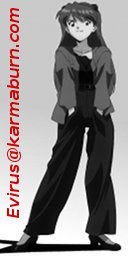|
|
- HOME
- Archive for RECOMMENDATIONS.
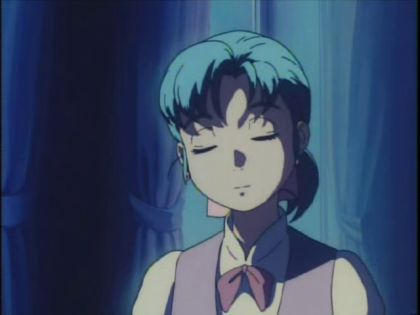
Alpha.
"More human than human." Those of you familiar with the phrase are probably thinking of Blade Runner. I'm thinking of Yokohama Kaidashi Kikou. Alpha is profoundly human—so much so that she brings life to that trope. That is, she is so human that her character is only believable to me because she is a robot. I guess I'm not explaining myself very well, but take a look at her response to the aftermath in Quiet Country Cafe and maybe you'll understand what I mean. Viewers unfamiliar with the YKK manga will probably find the OAVs somewhat perplexing, but Alpha's charisma compels watching nevertheless.
Posted in Blade Runner, RECOMMENDATIONS, Yokohama Kaidashi Kikou | Tags: Androids, Girls With Guns | Permanent Link
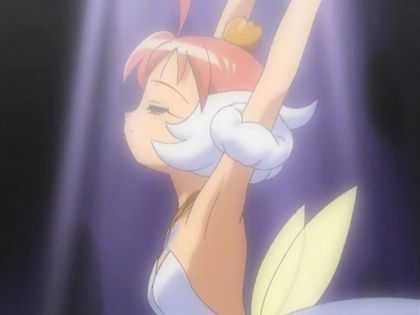
Princess Tutu.
I'm finally catching up with Nodame Cantabile again. If this doesn't inspire me to start buying classical music records again, maybe re-watching Princess Tutu will. Not that I need another excuse to re-watch Princess Tutu, mind you. You see, I recently bought the Princess Tutu compilation box set, so I have a pretty convenient excuse already. I'm a little peeved at spending seven dollars more for it than I needed to (you can get the ADV box set now for $27), but the series is worth much more than that, so I'll get over it.
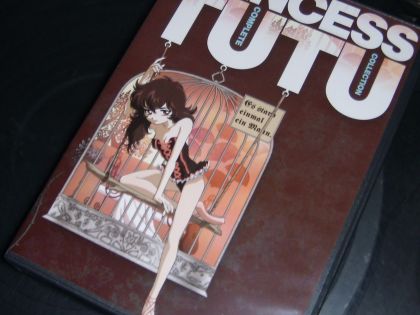
Rue displaces Ahiru for the Princess Tutu cover.
Regarding the box set, have you seen the cover art? Holy crap. Lest ye be misled, take note that this cover art is in no way representative of the contents of the show itself. Okay, the artists who developed Kraehe were surely working on a dissertation glorifying anime boobs, but aside from that, this cover art is nothing at all like the show itself.
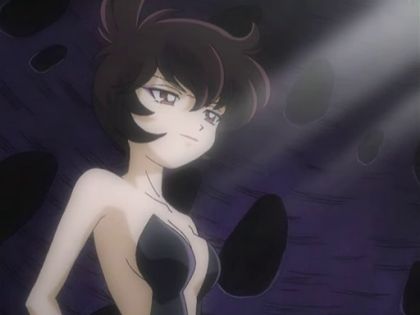
Princess Kraehe.
Of course, ADV probably chose misleading cover art intentionally, because damned if I know how else they're going to market a show like Princess Tutu. A pretty box with frilly pink ribbons and prancing ballet dancers would be more accurate and appropriate, but accurate and appropriate cover art ain't gonna inspire impulse buys—discounting impulse buys from anime fans that know the fourth act of Swan Lake by heart, naturally.

Princess Tutu.
So how does one sell a show about a little duck that turns into a young girl who turns into a magikal girl who saves people with the power of ballet? (Which is a BRILLIANT premise, by the way, but likely only in the eyes of people like me.) Sure, its soundtrack is almost entirely classical music, with a little boost from the late half of Melocure, but that's not going to sway the kind of customers who like to allege, "Anime is a medium, not a genre." [Spoilers: Those people are full of it.]
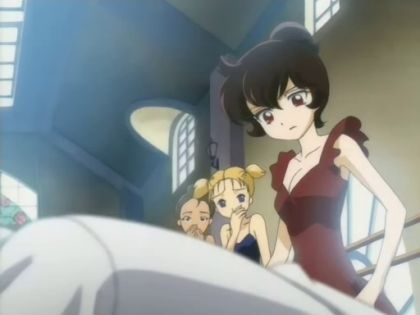
Rue.
I guess racy cover art featuring an emo ballerina squeezed into a merry widow is one way to go about it, and Rue does have legs that go up to her neck, but I advise potential buyers to simply sample the first few episodes. Watching the HnK/a.f.k. fansubs convinced me to buy the Princess Tutu Complete Collection DVDs despite being discouraged about ADV's Ahiru/Duck jazz. (Look, I don't care what your reason is; you can't subtitle the lead character's name as "Duck," okay?)
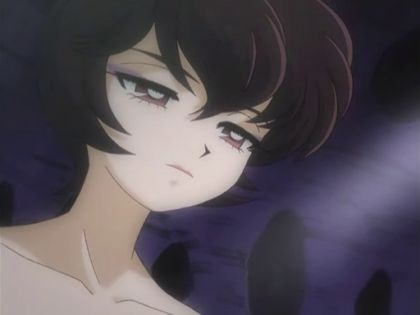
Odile sympathizers, you know who you are.
Be advised that the series changes drastically mid-series by revealing the heretofore unknown nature of multiple characters. Nothing contradicts the first half of the series, but the lack of antecedent leaves me wondering if they concocted those changes at the last minute in order to extend the length of the show. I'm not really complaining, because the show makes the changes work, and I would have bought the complete series on the strength of the first half alone. In fact, the second half of the series is also quite good; it just goes off in a different direction. If I have a complaint at all, I guess it's that the show didn't take its numerous Swan Lake references even further and just turned Princess Tutu into an anime adaptation of the ballet for Odile sympathizers, straight-up.
In related news, clockwork > steampunk.
Posted in Princess Tutu, RECOMMENDATIONS | Tags: Ballet, Banana Mizuki, Classical Music, Clockwork, DVDs and Blu-ray discs, Labor of Love, Legs that go up to her neck, Mahou Shoujo, Melocure | Permanent Link
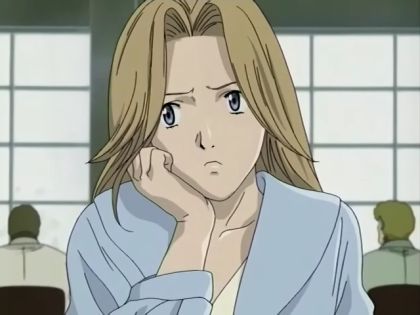
Nina is the Best Girl in Monster,
but with its cast that's pretty much a given.
How does one talk about Monster within the framework of a (mostly) diligent spoiler-free policy? It is difficult to discuss the plot of this 74-episode series without spoiling many of the key episodes that hinge on ambiguity and mystery for their hook, and it is impossible to provide episodic discussions without abandoning a spoiler-free policy altogether, since even trivial details from later episodes answer questions about events that happen (or don't happen, as it were) in the earlier episodes.
Posted in BEST GIRL, Monster, RECOMMENDATIONS | | Permanent Link
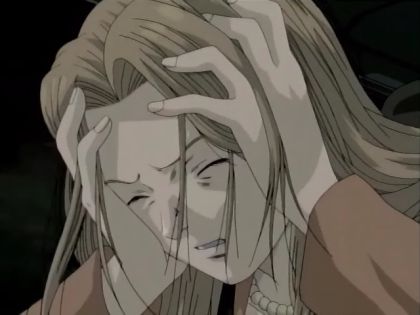
See no evil. Hear no evil.
In order to discuss Monster in a spoiler-free fashion, I have to avoid discussing the plot almost entirely, and may only speak of the characters in general terms. These restrictions are probably why I have not mentioned Monster much on these pages before, despite it being one of the few shows that I heartily recommend.
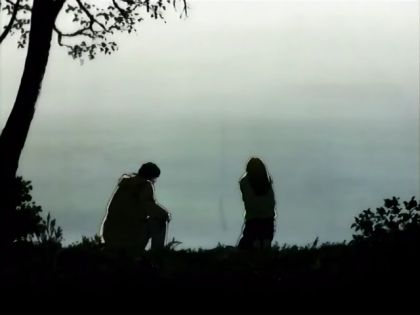
This scene sort of reminds me of an unrelated scene from Kaze no Yojimbo.
I don't recommend very many shows, but I do recommend Monster. Usually I don't broadly recommend shows because so much of what makes a show good or not depends on personal tastes and opinions. This is not to say that my reputation for being unusually tolerant of really shitty shows is at all warranted—merely that I acknowledge the shows I enjoy may be different than the shows y'all enjoy. Monster, on the other hand, is simply too good not to recommend.
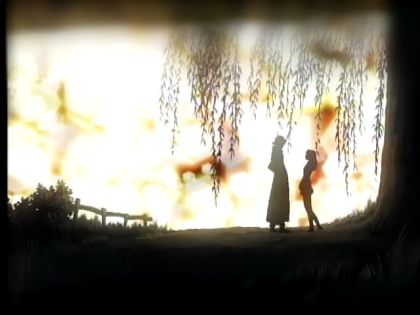
George and Miyuki are a bit happier than Kenzo and Nina, supra.
I suppose I have to talk about the plot at least a little bit. Concisely put, Monster is anime's answer to the old The Fugitive television series. I presume only a small percentage of today's anime fans have ever seen an episode of The Fugitive, so maybe I need to discuss the plot of Monster just a little bit more.
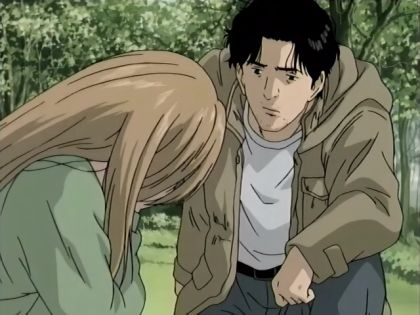
Nina and Dr. Tenma.
Doctor Kenzou Tenma is a Japanese physician living in Germany. He makes an ethical decision that proves politically unpopular. Dr. Tenma soon learns no good dead goes unpunished. His good deed continues to haunt him a decade later, eventually forcing him to run from the law while he in turn pursues his nemesis. Unlike Dr. Richard Kimble from The Fugitive, Dr. Tenma's prey is far more dangerous and murderous than "the one-armed man."
This is about all I can say about the plot without giving away clues that I wouldn't have wanted to know when I was watching Monster the first time. Now what?
Posted in Monster, RECOMMENDATIONS | | Permanent Link
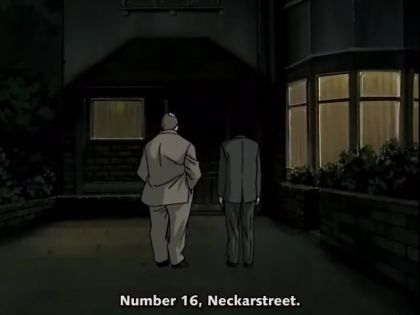
Google Maps disavows the existence of a
16 Neckarstrasse in Heidelberg, Germany.
If I can't talk about the plot of Monster, what else does that leave? Well, for one thing, there's the setting.
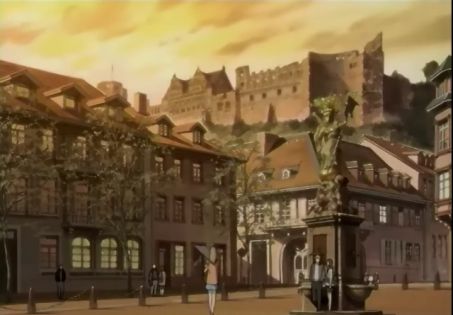
Nina begins her ascent to Heidelberg Castle.
Monster is one of the few anime series set outside Japan. Nearly all the scenes take place in mid-nineties Germany, as Dr. Tenma, his nemesis, and Inspector Lunge chase each other around. The settings are well-researched, with accurate cityscapes, landmarks, and other details (such as bus stop signs).

Tourists mill below the real Heidelberg Castle.
Monster is also the closest thing to a road movie that you're likely to find in anime. Thanks to Dr. Tenma's travels, the viewer is treated to new locales (mostly in Germany), many of which are introduced almost as characters themselves.
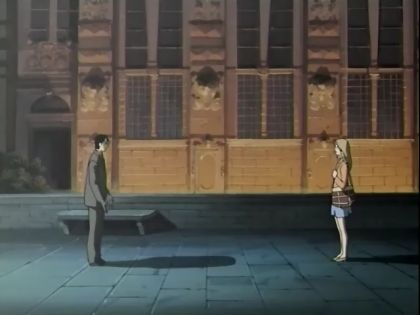
A troubling moment at Heidelberg Castle.
For example, when Monster introduces us to "The Girl from Heidelberg," we don't only get to meet the lovely Nina Fortner, we also visit the Heidelberg Schloss.

A quiet moment at Heidelberg Castle.
Various landmarks and landscapes are depicted accurately and prominently without detracting from the story. Other shows depict well-known settings similarly, but such settings are usually in Japan. (How many times have we seen Tokyo Tower or Big Site, for example.) The mere fact alone that Monster takes us into Europe makes the show worth a look, although I suspect most viewers will be too quickly hooked by the captivating story to go sightseeing.
Posted in Monster, RECOMMENDATIONS | Tags: 3D, Anime Tourism, Mamikore | Permanent Link
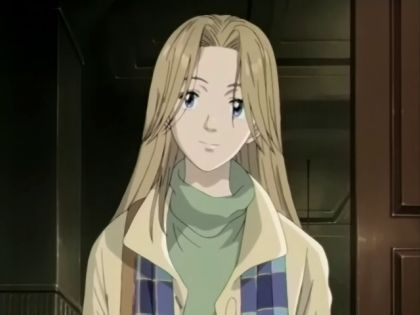
Nina Fortner having a good day.
There is another reason to watch Monster that I haven't mentioned: Nina Fortner may be Noto Mamiko's best role. It allows her to play against her typecast with a good character in an excellent series. (Monster isn't Witchblade. Okay?) Nina is pretty easy to like because she's the damsel in distress who can take care of herself but is still limited by what she can accomplish herself. I.e., Nina is vulnerable, but far from helpless.
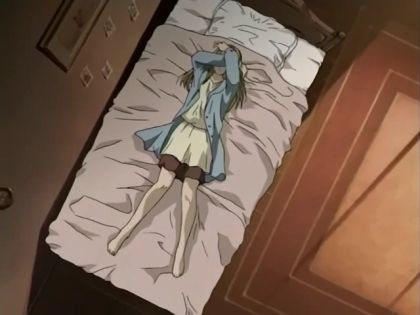
Nina Fortner having a bad day.
As an aside, I think Noto Mamiko should do more Nina Fortner-type roles. There's no question she is typecast by her outstanding Shimako and Yakumo-type performances as gentle and well-mannered, unapproachably beautiful girls. Her enthusiastic Narue in Narue no Sekai is unusually chipper, but usually any other departure from her usual mold leaves Mamiko either playing left field for a sinking ship (e.g. Witchblade) or as unassertive male characters (e.g. Girls Bravo) that could really would have been just as good if not better had they been female (e.g. Full Metal Panic!).
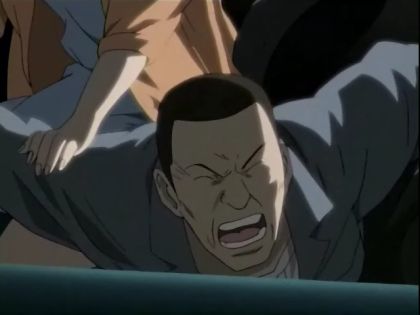
When Nina Fortner has a bad day, you have a bad day.
I'm not going to go so far as to say that nobody besides Noto Mamiko could have played Nina Fortner as well, but I do believe the softness of her voice contributes a great deal to the role and helps balance the dichotomy of the character that makes Nina so engaging. It's MAMIKORE.
Posted in Monster, RECOMMENDATIONS, Seiyuu | Tags: Mamikore | Permanent Link
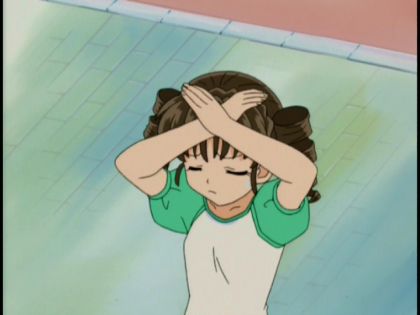
If you don't own any Full Moon wo Sagashite DVDs, you're wrong.
How many Full Moon wo Sagashite DVDs do you own? I have seven, and I would own more except there hasn't been a new release since December 2007. Given the shape of the current anime market (i.e. the bubble popped—predictably, I might add), it makes me worry if we'll ever see the six or so remaining discs.
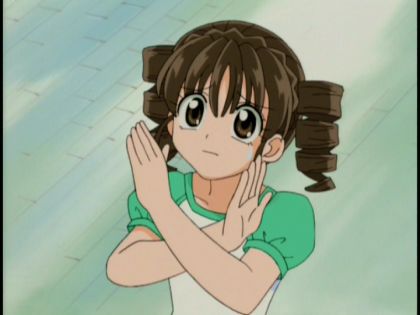
If you've never watched Full Moon wo Sagashite, you're really wrong.
I understand Full Moon wo Sagashite is somewhat of a difficult title to market. For years, it was often lamented as one of the "this will never get licensed, EVER" shows along with To Heart and Kokoro Library. Well, we got two out of three, but Full Moon wo Sagashite is 52 episodes long and a shoujo clock show to boot. It's got one of the best endings of all time, but how do you get people there? Gunbuster has one of the best endings of all time, too, but it's only a six-episode investment.
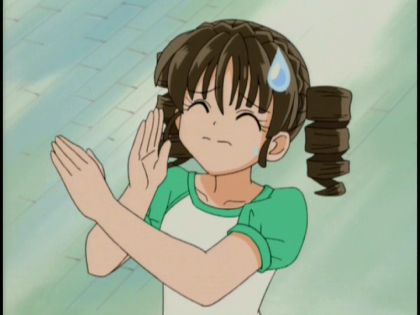
Yes, I'm serious.
How do you convince people to commit to a 13-disc series? Hell, I went years without watching even a minute of the show despite hearing exceptionally rave reviews from people with established credibility I could trust. And I watched it for free. But, come on, it's about a 12-year-old girl dying of throat cancer who transforms into a 16-year-old girl to become a singer.

You're going to have to trust me on this one.
But it's more than that. I finally decided to give it a chance after seeing a screenshot featuring two shinigami characters. Now, I had watched enough anime by that point to develop a mental image of what shinigami might look like (and no, they weren't anything like Momo, and only a little bit like Rukia). Meroko and Takuto were not what I had in mind.
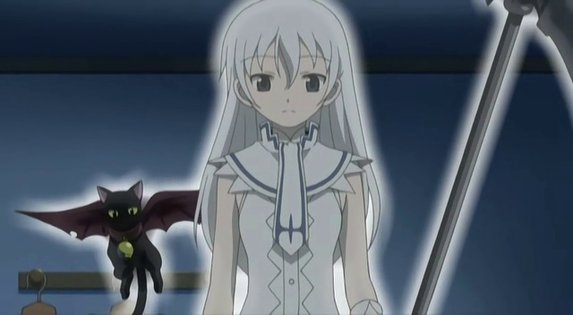
Daniel and Momo from Shinigami no Ballad.
So I figured Full Moon wo Sagashite had to be at least a little different. I set my reservations aside and gave the show a chance without preconceptions. Turns out, it is different. And it also turns out Full Moon wo Sagashite is really damn good.

Madoka should have believed in Takasu who believed in her.
This is one of the very few shows I broadly recommend. And I also encourage all y'all to buy the DVDs, because quite frankly I suspect the title probably could use more sales. I hope the long interruption since the last release (with no release date for the next installment in sight) isn't indicative of abandonment—but even if it is, maybe it's time to put your money where your mouth is. That is, just how committed to "supporting the industry" are you? If ever there was a series that deserves it, it's Full Moon wo Sagashite.
Posted in Full Moon wo Sagashite, RECOMMENDATIONS, Shinigami no Ballad | Tags: Mahou Shoujo | Permanent Link

Pacifica.
I've started re-watching Scrapped Princess again. Has it been five years already? I loved this show when it first aired, as did most other viewers at the time, but now it seems I hear negative opinions more often than positive views whenever I notice Scrapped Princess mentioned at all. Has it really aged that poorly?
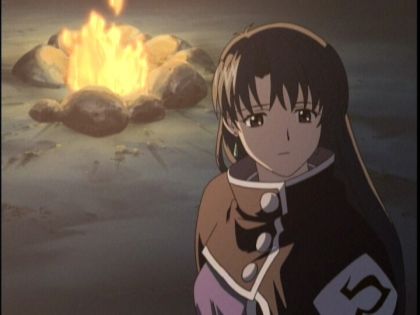
Raquel.
Re-watching the series with the benefit of hindsight, I'm still impressed by all the elements that made Scrapped Princess a great show to watch the first time around. First of all, its pacing and timing is impeccable, particularly in the comic scenes. The most important facet of comedy is timing; through the early episodes, Scrapped Princess is perfect. Second, the music is great. Watching Scrapped Princess, I appreciate that it has an actual musical score, as opposed to random bits of filler background music as you'll find all too often. Third, this series is heavy on cliffhangers. Cliffhangers probably won't impact your enjoyment of the show if you're marathoning the series in batches, but when I was watching it for the first time, they certainly kept the anticipation high from week to week.
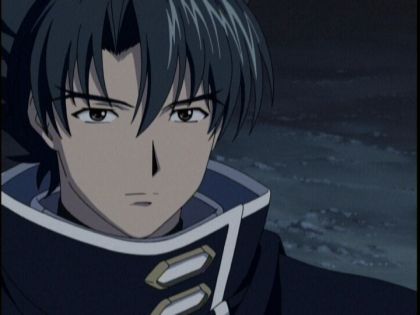
Shannon.
Seeing as how the series aired five years ago, I suppose there could be some readers who know very little about Scrapped Princess. Here are the basics:
- A prophecy predicts Pacifica Casull will destroy the world when she turns 16. The series begins with the 15-year-old Pacifica running from the Mauser theocracy. Its faithful are trying to kill her to keep the prophecy from coming true.
- The setting of Scrapped Princess follows sword and sorcery idioms, but is it magic...or just something indistinguishable from magic?
- Most of the names are borrowed from real-world firearm manufacturers. E.g., Casull, Mauser, Steyr, CZ, Armalite, Winchester (Winia Chester), et cetera.
- Pacifica likes eggs. And how.
- All the female characters have zero-gravity breasts vacuum-sealed into revealing outfits. Okay, not Raquel—at least not often.
- Pacifica takes a lot of baths. And how.
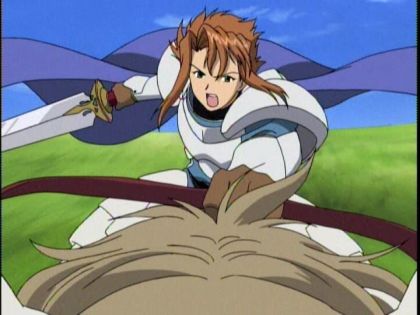
Leo.
But is Scrapped Princess any good? Hell yes. Nobody should have any complaints about the first half of the series. There is a plot device in the second half of the series that a lot of people don't like, but I'll address it once I get that far again.
Posted in RECOMMENDATIONS, Scrapped Princess | | Permanent Link
|
|



